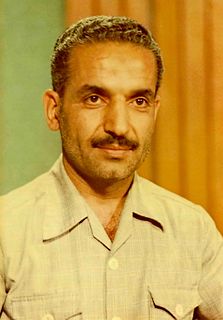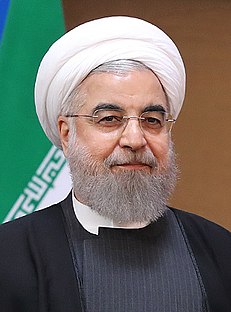| |||||||||||||||||
| Registered | 30,139,598 [1] | ||||||||||||||||
| Turnout | 54.59% [1] | ||||||||||||||||
| |||||||||||||||||
| |||||||||||||||||
The Iranian presidential election of 1989 took place on July 28, 1989, after the death of Ayatollah Ruhollah Khomeini and the selection of Ayatollah Ali Khamenei, the previous President of Iran, as the new Supreme Leader of Iran. Out of the seventy-nine candidates registered to run, only two were approved by the Council of Guardians, which resulted in a very predictable win by Akbar Hashemi Rafsanjani, the previous Speaker of Majlis.

The President of Iran is the head of government of the Islamic Republic of Iran. The President is the highest ranking official of Iran. The President carries out the decrees, and answers to the Supreme Leader of Iran, who functions as the country's head of state. Unlike the executive in other countries, the President of Iran does not have full control over anything, as these are ultimately under the control of the Supreme Leader. Chapter IX of the Constitution of the Islamic Republic of Iran sets forth the qualifications for presidential candidates. The procedures for presidential election and all other elections in Iran are outlined by the Supreme Leader. The President functions as the executive of the decrees and wishes of the Supreme Leader. These include signing treaties and other agreements with foreign countries and international organizations, with Supreme Leader's approval; administering national planning, budget, and state employment affairs, as decreed by the Supreme Leader. The President also appoints the ministers, subject to the approval of Parliament, and the Supreme Leader who can dismiss or reinstate any of the ministers at any time, regardless of the president or parliament's decision. The Supreme Leader Ali Khamenei directly chooses the ministries of Defense, Intelligence and Foreign Affairs, as well as certain other ministries, such as the Science Ministry. Iran’s regional policy is directly controlled by the office of the Supreme Leader with the Ministry of Foreign Affairs’ task limited to protocol and ceremonial occasions. All of Iran’s ambassadors to Arab countries, for example, are chosen by the Quds Corps, which directly reports to the Supreme Leader.

The Supreme Leader of Iran, also referred to as Supreme Leader of the Islamic Revolution, but officially called the Supreme Leadership Authority, is the head of state as well as the ultimate political and religious authority of the Islamic Republic of Iran. The armed forces, judiciary, state television, and other key government organizations are subject to the Supreme Leader. The current longtime officeholder, Ali Khamenei, has been issuing decrees and making the final decisions on economy, environment, foreign policy, education, national planning, and everything else in Iran. Khamenei also makes the final decisions on the amount of transparency in elections, and has dismissed and reinstated presidential cabinet appointees. The Supreme Leader directly chooses the ministers of Defense, Intelligence and Foreign Affairs, as well as certain other ministers, such as the Science Minister. Iran's regional policy is directly controlled by the office of the Supreme Leader with the Ministry of Foreign Affairs' task limited to protocol and ceremonial occasions. All of Iran's ambassadors to Arab countries, for example, are chosen by the Quds Corps, which directly report to the Supreme Leader.

Iran, also called Persia, and officially the Islamic Republic of Iran, is a country in Western Asia. With over 81 million inhabitants, Iran is the world's 18th most populous country. Comprising a land area of 1,648,195 km2 (636,372 sq mi), it is the second largest country in the Middle East and the 17th largest in the world. Iran is bordered to the northwest by Armenia and the Republic of Azerbaijan, to the north by the Caspian Sea, to the northeast by Turkmenistan, to the east by Afghanistan and Pakistan, to the south by the Persian Gulf and the Gulf of Oman, and to the west by Turkey and Iraq. The country's central location in Eurasia and Western Asia, and its proximity to the Strait of Hormuz, give it geostrategic importance. Tehran is the country's capital and largest city, as well as its leading economic and cultural center.
Contents
The Iranian constitution was amended by referendum on the same day.













